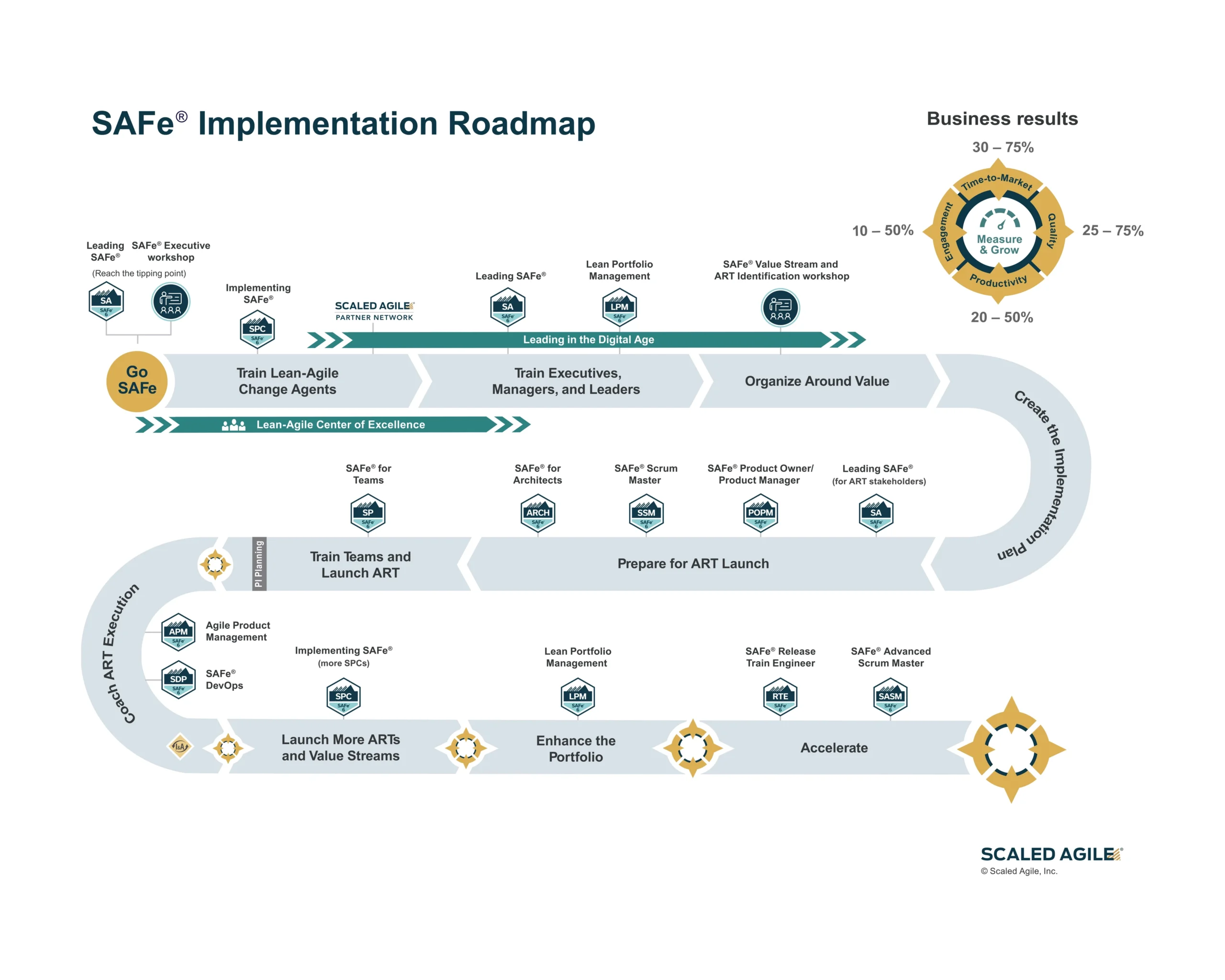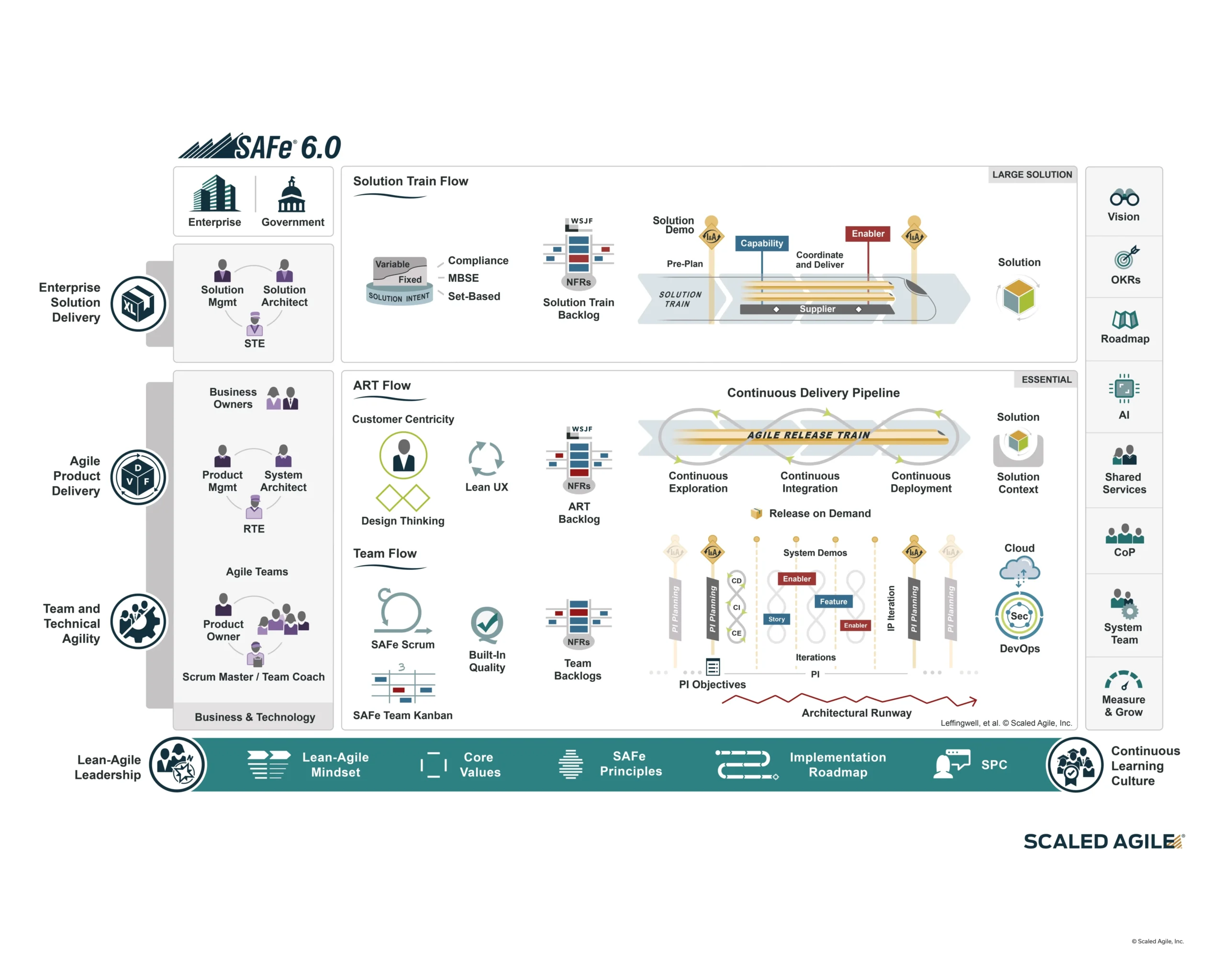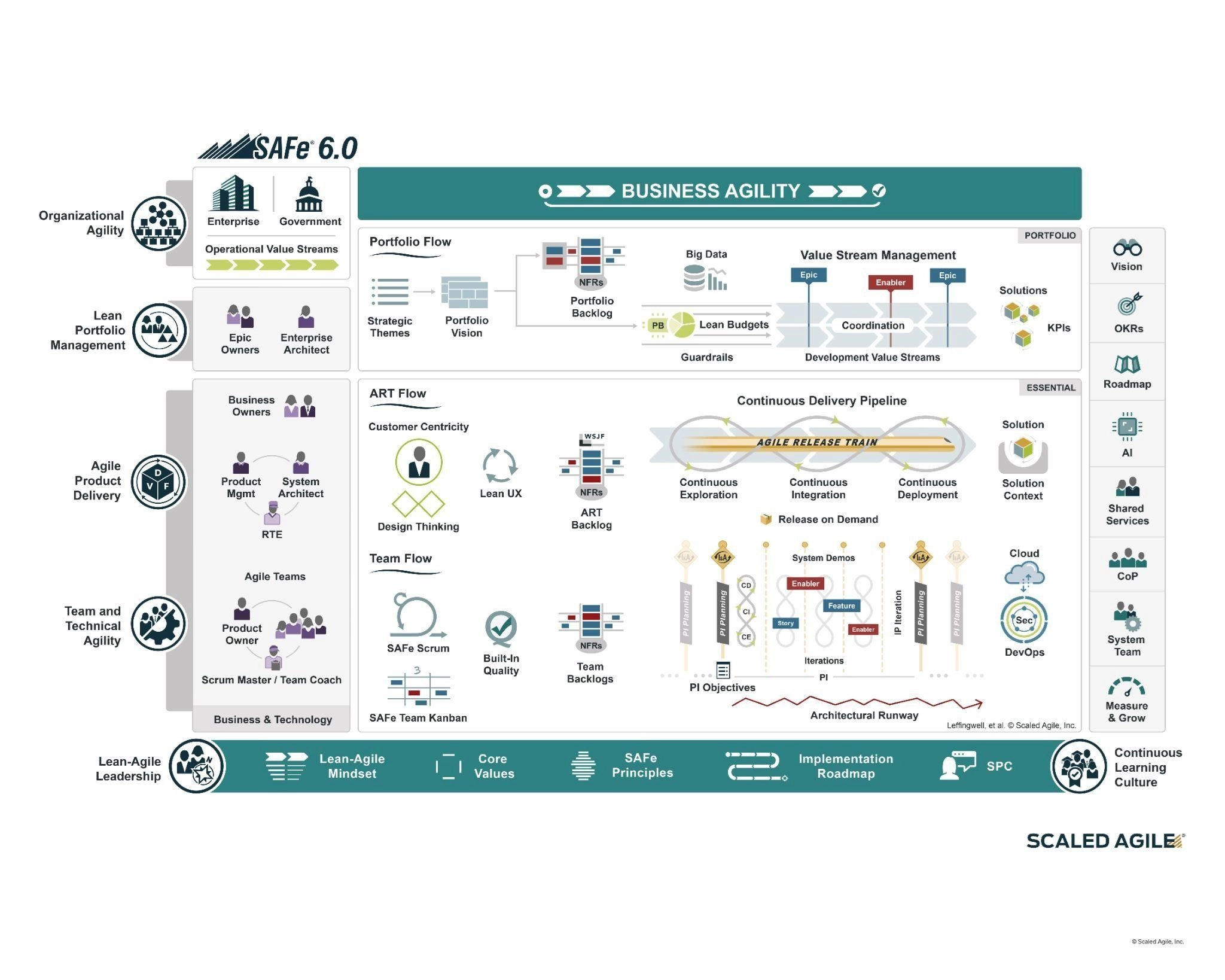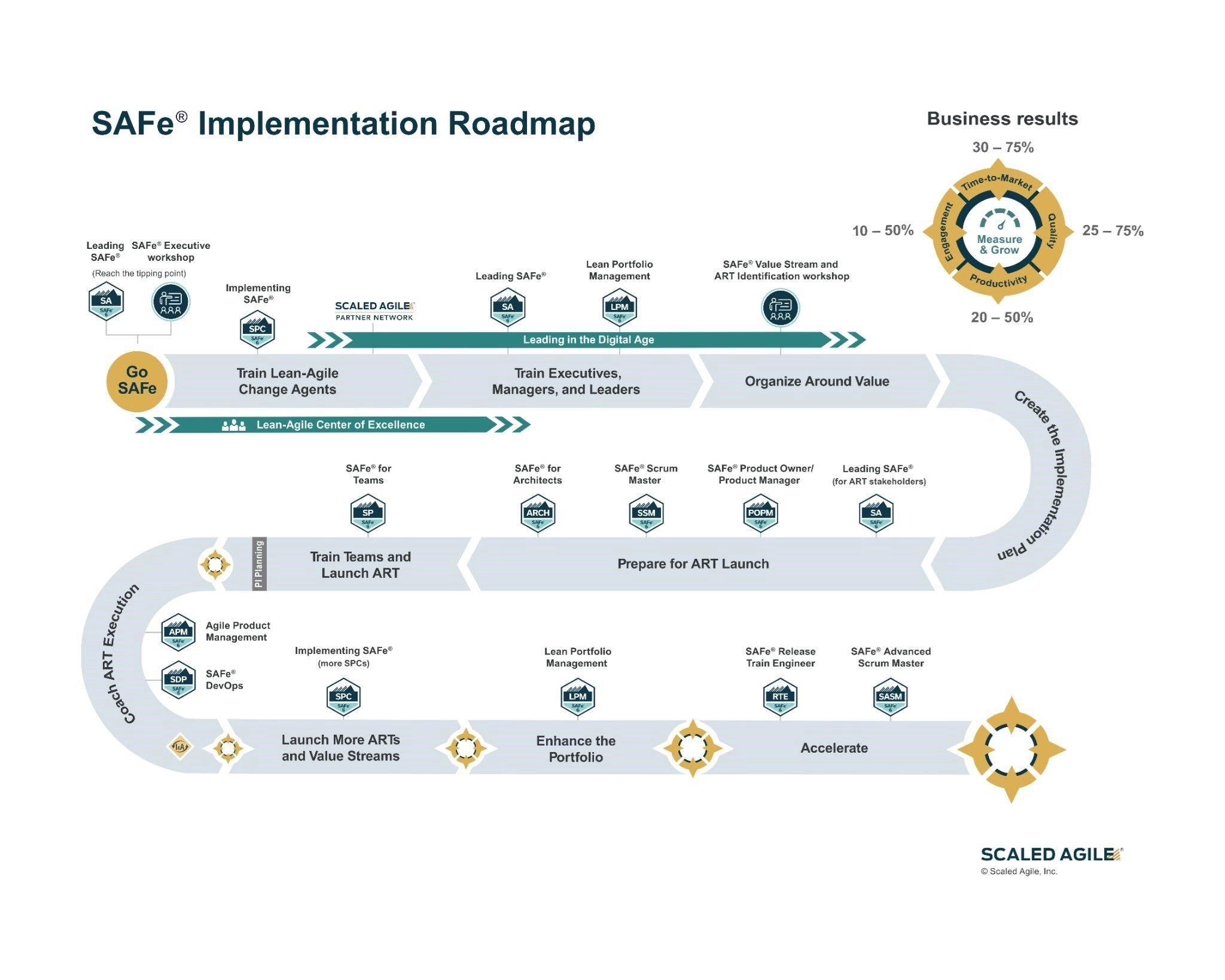Corporations and large companies often face a paradox: dozens or hundreds of talented developers work on projects, but the results are not impressive. Endless approvals slow down processes, while competitors release innovative products faster.
SAFe – a framework for scaling Agile – offers a way out of this situation. SAFe helps organize large teams in a way that preserves the flexibility and speed of smaller startups. We tell you what this framework is, how it works and what you need to implement the practices in your company.
What is SAFe (Scaled Agile Framework)
SAFe is a set of tools for scaling agile approaches in large companies. The framework combines best practices from the world of Agile, lean manufacturing, and systems thinking. It tells you how to assign roles, plan work, and manage processes so that dozens or hundreds of people are moving in the same direction.
SAFe is especially useful when 50 people or more are working on a project. For example, a bank is developing a new mobile application: programmers, designers, testers, analysts are working on it – and that’s just in the IT department. And then there are lawyers, marketing specialists, and the security service. SAFe helps all these employees understand the common goal and contribute to the creation of the product.
The main idea of SAFe is to organize teams into “trains” (Agile Release Trains or ART). Each such “train” creates some value for users. For example, one ART may be responsible for payment functions in the app, another for the client’s personal cabinet.
SAFe does not require a revolution in the company. It allows you to gradually introduce flexible approaches, starting with a few teams and expanding to the level of the entire organization. At the same time, the framework is flexible enough to be adapted to the specifics of a particular business – it is not an out-of-the-box solution, but rather a map that helps a company find its way to more flexible and efficient work. SAFe suggests what steps to take to organize work, but it does not replace common sense and understanding of the specifics of the business.
Benefits of SAFe for large companies
Implementing SAFe does not solve all the problems of a large organization, but for large companies that are ready for change, this framework will help them better adapt to changes in the market. Apart from this, SAFe has other pros for large businesses:
- SAFe allows you to extend Agile principles to the entire company – agile teams do not work in isolation, but move in the same direction.
- Actions become more coordinated – teams work autonomously, but their efforts add up to a common result.
- The framework allows you to manage dependencies in large projects when one team’s work depends on another. SAFe acts like a traffic light system that helps traffic flows move without collisions.
- SAFe makes work transparent at all levels of the organization: executives see the big picture, middle managers understand how their area fits into the whole, and teams know how their work affects the overall result.
- With regular demonstrations and clear planning, companies can more accurately forecast product timelines and functionality.
- The entire SAFe workflow is focused on creating value for the user, which helps companies stay competitive and better meet the needs of their customers.
Differences of SAFe from other scaling frameworks
SAFe stands out among other Agile scaling approaches for its versatility and depth of development, and can also be compared to other popular frameworks on a number of criteria:
| SAFe | Other frameworks (LeSS, SoS, Nexus) | |
| Scale of application | Suitable for large organizations with hundreds or even thousands of employees, such as large banks and corporations. | Focused on smaller scales – up to 8-9 teams, such as in a startup that has grown to 100-150 employees.
|
| Structure and flexibility | There is a clear hierarchy of levels: team, program, major solution, portfolio.
|
Try to keep Scrum simple – these frameworks have fewer new concepts and more from the original Scrum. |
| Roles and Processes | Introduces new roles, such as Release Train Engineer, who ensures the operation of ART “trains,” which are also a unique SAFe entity. | A minimum of new roles are introduced.
|
| Planning approach | The concept used is Program Incremental Planning (PI Planning), which is a large strategy session where all teams work together to plan the work for the months ahead. | Maintains the more traditional Scrum sprint planning by simply extending it to multiple teams.
|
| Integration with business strategy | Links developers’ day-to-day tasks with global business goals. | Less touching on strategy issues, focusing mainly on team coordination.
|
| Flexibility of implementation | It has several configurations, from basic Essential SAFe to full SAFe, allowing companies to start small and gradually expand. | Provide more radical changes to the structure of the organization from the start.
|
Configurations of the Scaled Agile Framework
SAFe is like a constructor – from the elements of the framework, you can build a solution that is perfect for your company. The framework has four basic configurations, each of which is suitable for organizations of different size and complexity:
Essential SAFe
This is the basic configuration – the foundation for all the others. Essential SAFe is suitable for companies with 5 to 12 teams (approximately 50-125 people) working on a single product.
Key elements:
- Agile Release Train (ART) – a group of teams working on a common product;
- Program Increment (PI) – a planning and development period, typically 8-12 weeks;
- Roles: Scrum Master, Product Owner, Release Train Engineer
Source © 2024 Scaled Agile, Inc.
Large Solution SAFe
When a product grows and becomes more complex, you need a Large Solution configuration. It is appropriate when there are multiple ARTs working on the product or when external vendors are involved in the project.
Additional Elements:
- Solution Train – coordination of multiple ARTs;
- Solution Management – managing a large solution;
Source: safe.scaledagile.com © 2024 Scaled Agile, Inc.
Portfolio SAFe
This configuration is needed when a company manages multiple products or lines of business. Portfolio SAFe helps align teams with the overall company strategy and efficiently allocate resources between projects.
Key Elements:
- Strategic Themes – company development directions;
- Lean Portfolio Management – flexible project portfolio management;
- Epic Owners – responsible for major initiatives;
Source: safe.scaledagile.com © 2024 Scaled Agile, Inc.
Full SAFe
The most complete configuration that includes all levels and elements of SAFe. Full SAFe is suitable for large enterprises with hundreds to thousands of employees working on multiple complex products.
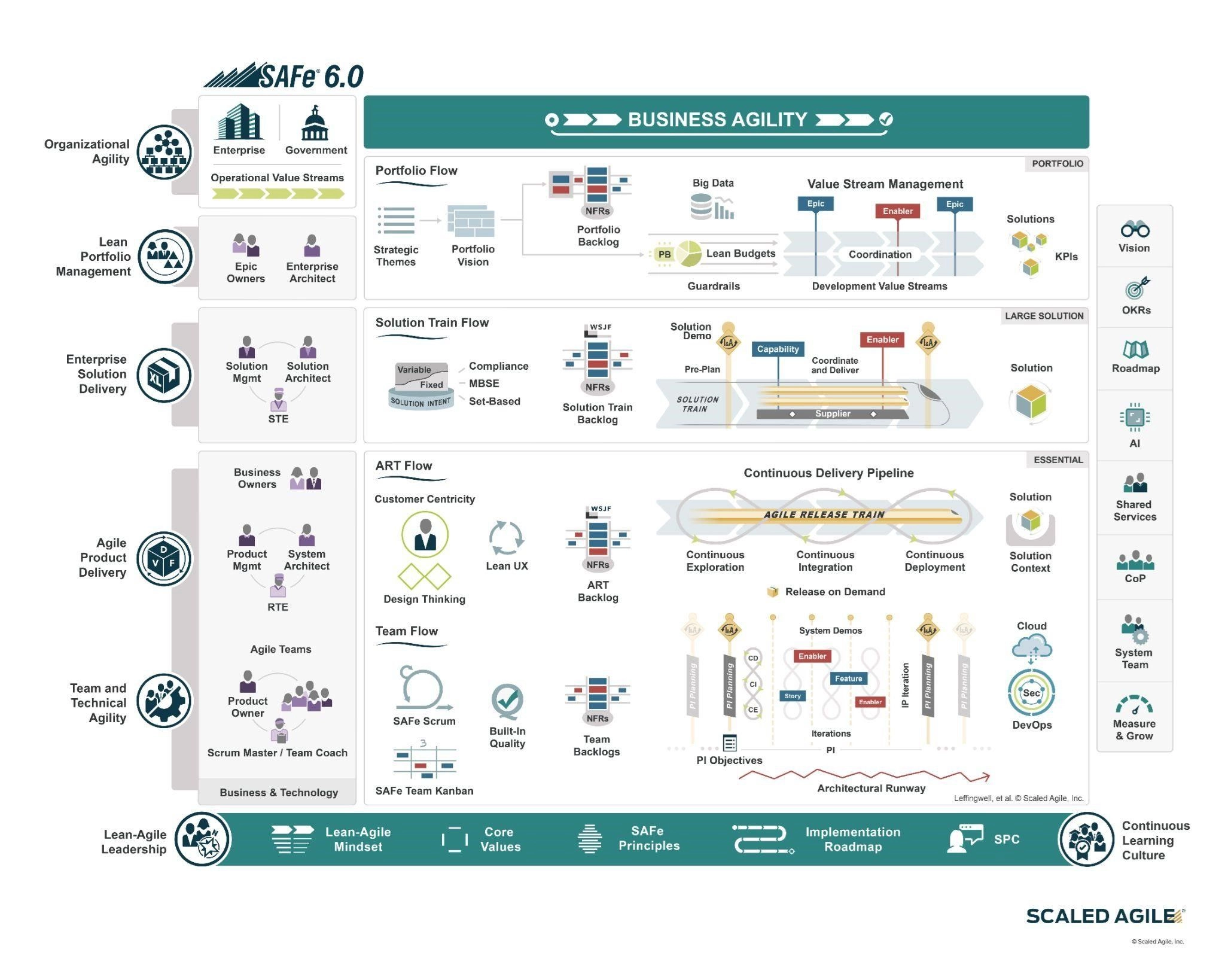
Source: safe.scaledagile.com © 2024 Scaled Agile, Inc.
Important note: A company doesn’t have to aim for Full SAFe right away. You can start with an Essential configuration and gradually add elements as the organization grows and becomes more complex. For example, the IT department of a large bank might start with Essential SAFe to develop a single product, then move to Large Solution SAFe as the product becomes more complex, and finally implement Portfolio SAFe to manage the bank’s entire range of digital services.
- Consider the economic aspects — make decisions taking into account the economic context; evaluate the costs, risks and benefits of each decision.
- Apply systems thinking — consider the project as part of a large system; optimize the whole, not individual components.
- Consider the variability — do not fixate on one solution at the beginning of the project; explore several options and narrow down the choice based on the data.
- Develop solutions iteratively, getting quick feedback — this reduces risks and allows you to adapt faster.
- Evaluate progress based on a really working product — use ready-made solutions as a basis for making decisions and evaluating progress, do not rely only on plans and documents.
- Ensure a continuous flow of value creation; eliminate obstacles and reduce delays in the development process.
- Synchronize through cross-domain planning — coordinate the work of different teams and areas through joint planning.
- Uncover the internal motivation of employees — create an environment where people can show initiative and creativity.
- Decentralize decision—making – allow teams to solve local issues on their own, while maintaining centralized control over the strategy.
- Organize around value — form teams and processes around value streams rather than functional departments.
The SAFe Values
| Consistency
● Clearly communicate the company’s vision, mission and strategy; ● link strategy to specific team actions; ● use a common language to describe roles and processes; ● regularly check that everyone understands the objectives correctly.
|
Transparency
● Create an atmosphere of trust within the team; ● communicate openly and honestly, without embellishments; ● accept mistakes as an opportunity to learn; ● visualize the workflow using kanban boards; ● provide easy access to the information you need.
|
| Respect for people
● Appreciate the uniqueness of each employee; ● Encourage diversity of opinion and approach; ● develop people through coaching and mentoring; ● treat colleagues as internal customers; build long-term partnerships based on mutual benefit. |
Continuous Improvement
● Create a sense that improvement is necessary; ● foster a culture of problem solving; ● Analyze and adapt processes regularly; ● Build a culture of problem solving; ● Analyze and adapt processes regularly; ● allocate time and resources for innovation.
|
How does SAFe work?
SAFe is a flexible framework that can and should be adapted to the specifics of the organization. A company can start by implementing the basic elements and gradually expand the use of the framework as the company grows and develops. SAFe organizes the work of large companies through several key elements and processes:
Agile Release Trains (ART).
An ART is a group of Agile teams working on a common product or value stream.
Program Increment (PI) Planning
PI Planning is a two-day event where teams plan work for the next 8-12 weeks. This is where tasks are discussed, dependencies are identified, and risks are assessed.
Iterations
After PI Planning, the work is done in two-week iterations. At the end of each iteration, teams demonstrate progress and adjust plans.
System Demo
At the end of each iteration, there is a general system demo where teams show what has been accomplished.
Managing the Value Stream
SAFe uses Kanban boards, performance metrics, and continuous improvement practices to optimize workflows.
Key Roles in SAFe
- Release Train Engineer (RTE) – ensures the cohesive operation of the entire ART;
- Product Manager – determines the direction of product development;
- Scrum Master – helps teams work efficiently;
- Scrum Master – helps teams work efficiently;
- Product Owner – responsible for a specific part of the product;
- Product Owner – responsible for a specific part of the product;
DevOps and Continuous Delivery
SAFe integrates DevOps practices to deliver the product to users quickly and reliably.
Synchronization and Integration.
Regular meetings ensure coordination between teams and consistency in product development.
Using specialized development management tools
The use of specialized IT solutions for the organization of development will help you work on SAFe more productively – modern solutions such as SimpleOne SDLC allow you to manage development comprehensively, taking into account all products in the company’s portfolio and tasks in the backlog.
SimpleOne SDLC helps coordinate IT product development and collaboration between development and technical support teams:
- A team development solution: Agile boards (Scrum, Kanban), planning and accounting of labor costs;
- Combining development and technical support teams: end-to-end ITSM processes in development management;
- Product portfolio management: from a small project to building a complex product structure and hierarchy;
- Rich REST API;
- Reports of various types: Agile metrics, custom report forms, standard and custom dashboards;
- Customization with No/Low-code support — the ability to develop system modules for your own needs thanks to the tools of the SimpleOne platform and detailed, open documentation;
- Automatic adaptation to the mobile version.
How to implement SAFe
SAFe implementation begins when a tipping point is reached – the point at which a company is ready for a major change. This may be triggered by a competitor launching an innovative product or the realization that the current strategy is leading to a crisis.
When the tipping point is reached, employees are more open to change. Without it, implementation will face strong resistance.
Scaled Agile, Inc. has developed a roadmap of 13 steps for implementing SAFe:
- The turning point
- Training Lean-Agile change agents
- Creating a Lean-Agile competency center
- Training executives, managers and leaders
- Leading in the digital age
- Organizing around value
- Creating an implementation plan
- Preparing for the ART launch
- Training teams and launching ART
- Coaching ART execution
- Launching additional ART and value creation streams
- Portfolio Development
- Acceleration
Source: safe.scaledagile.com © 2024 Scaled Agile, Inc.
The main thing about SAFe
- SAFe is a framework for scaling Agile in large companies. It helps to organize the work of hundreds of employees on complex products, while maintaining the flexibility and efficiency of small teams. SAFe combines the practices of Agile, Lean manufacturing and systems thinking.
- The key idea of SAFe is the organization of teams in Agile Release Trains (ART). These are groups of 5-12 teams working on a common product or value stream. ART helps to synchronize the work of different departments and specialists.
- SAFe has four configurations: Essential, Large Solution, Portfolio and Full SAFe. A company can start with a basic configuration and gradually expand the use of the framework as processes grow and become more complex.\
- The framework is based on 10 principles and 4 core values. They shape the culture of the organization and help make decisions at all levels.
- SAFe introduces new roles and processes. For example, the Release Train Engineer coordinates the work of ART, and the Program Increment Planning are regular meetings where teams plan work for 8-12 weeks ahead.
- SAFe implementation is a step—by-step process. Scaled Agile, Inc. has developed a roadmap of 13 steps, starting from reaching a tipping point and ending with accelerating processes. Each step helps to gradually transform the organization.
